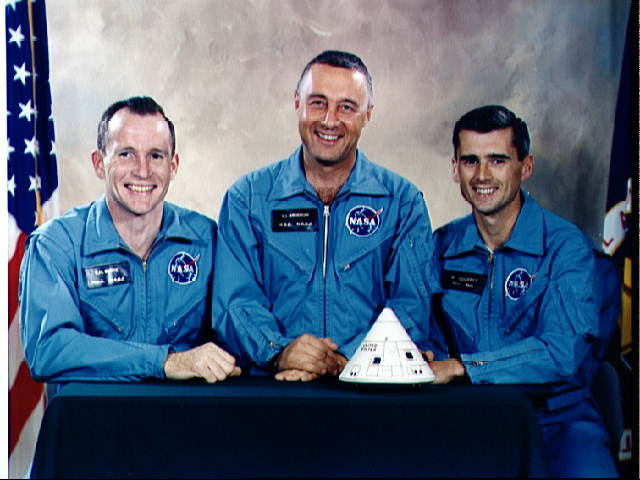Some space history moments we might rather forget … but in some ways they’re more important to remember. Like this one.
Forty-five years ago today — January 27, 1967 — the Apollo-1 capsule caught fire during an on-pad test, killing astronauts Virgil I. “Gus” Grissom, Edward H. White II, and Roger B. Chaffee.

(The Apollo-1 crew. L-R: White, Grissom, Chaffee. NASA image.)
Originally known as AS-204 (Apollo-Saturn-204), the mission was scheduled to be launched on February 21st. The test being run was officially known as the Space Vehicle Plugs-Out Integrated Test, Operational Checkout Procedures (OCP) FO-K-0021-1, and was intended to “demonstrate all space vehicle systems and operational procedures in as near a flight configuration as is practical and to verify their capability in a simulated launch.” The specific objectives were:
- To verify overall spacecraft/launch vehicle compatibility and demonstrate proper function of spacecraft systems with all umbilicals and Ground Support Equipment disconnected.
- To verify no electrical interference at the time of umbilical disconnect.
- To verify astronaut emergency egress procedures (unaided egress) at the conclusion of the test.
That last objective was actually added by the astronauts themselves, “because a subsequent test, Countdown Demonstration, would involve a fully fueled Launch Vehicle and this latter test was identified as hazardous.”
Unfortunately, few if any of the operators and engineers had considered how hazardous the Plugs-Out test conditions would turn out to be.
The Review Board’s Findings, Determinations And Recommendations found that power failed in the capsule momentarily, and several electrical arcs occurred but “no single ignition source of the fire was conclusively identified.”
The most probable initiator was an electrical arc in the sector between -Y and +Z spacecraft axes. The exact location best fitting the total available information is near the floor in the lower forward section of the left-hand equipment bay where Environmental Control System (ECS) instrumentation power wiring leads into the area between the Environmental Control Unit (ECU) and the oxygen panel.
What made the Command Module more dangerous than anticipated were “many types and classes of combustible material in areas contiguous to possible ignition sources,” and the test being conducted “with a 16.7 pounds per square inch absolute, 100-percent oxygen atmosphere.” With respect to the spacecraft itself, the investigators found “deficiencies [in] design, workmanship and quality control,” some of which were:
- Components of the Environmental Control System installed in Command Module 012 had a history of many removals and of technical difficulties including regulator failures, line failures and Environmental Control Unit failures. The design and installation features of the Environmental Control Unit makes removal or repair difficult.
- Coolant leakage at solder joints has been a chronic problem.
- The coolant is both corrosive and combustible.
- Deficiencies in design, manufacture, installation, rework and quality control existed in the electrical wiring.
- No vibration test was made of a complete flight-configured spacecraft.
- Spacecraft design and operating procedures currently require the disconnecting of electrical connections while powered.
- No design features for fire protection were incorporated.
When the fire started during the Plugs-Out test, it spread rapidly and increased the pressure in the capsule, which sealed the inner hatch so tightly that the crew could not open it. Eventually the Command Module actually ruptured, spreading fire into the surrounding structure, but by that time the crew had died “from asphyxia due to inhalation of toxic gases due to fire.”
The investigation into the accident led to many significant improvements in the vehicle design, as well as better test and flight procedures that made the ensuing Apollo missions much safer. It’s unfortunate that the cost of those lessons was so high, but that seems to be the case with many of the important lessons we learn.
May we never forget.



 by
by 


















